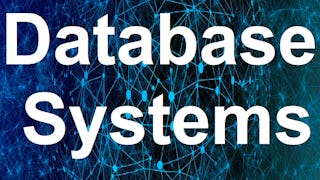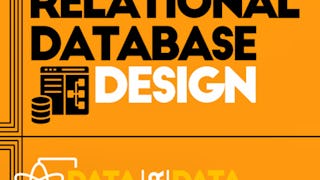Data Management and Database Design Part 2 advances your database expertise with performance optimization, advanced SQL, enterprise administration, and cloud technologies. Complete your project database while mastering production-level skills in security, scaling, and distributed systems. Build the advanced competencies needed for senior database and data architect roles.

Ends in 3 days. Heat up your career with courses from Google, IBM, and more for £190/year. Save now.


Skills you'll gain
Details to know

Add to your LinkedIn profile
July 2025
11 assignments
See how employees at top companies are mastering in-demand skills

There are 7 modules in this course
In Module 8, you will learn the critical aspects of transaction management and concurrency control in database systems, which are essential tools for maintaining data integrity and performance in multi-user environments. This module is also designed to help you evaluate different concurrency control mechanisms and understand their implications on data integrity and transaction efficiency. You'll learn to analyze transaction blocking and understand its effects on database operations, equipping you with the skills to design more reliable and consistent database systems.
What's included
4 videos14 readings2 assignments1 discussion prompt
In Module 9, we tackle the multifaceted challenges of data security, encryption, and effective data presentation within database environments. Through this module, you will deepen your understanding of data vulnerabilities and the strategies used to mitigate them, assess various encryption algorithms for protecting sensitive information, and develop skills in creating streamlined reports in horizontal reporting format for efficient data analysis. You will also gain proficiency in manipulating graph data by leveraging advanced SQL programming techniques to handle complex data structures effectively.
What's included
2 videos20 readings2 assignments
In Module 10, you will explore the critical components of data governance and advanced SQL server-side programming, enhancing your ability to manage and manipulate organizational data effectively. This module will provide you with a thorough understanding of the principles of data governance, including its role in ensuring data quality, usability, and security. You will also analyze the advantages and limitations of SQL server-side modules compared to client-side code and learn to design and implement SQL functions and stored procedures for efficient data processing. Additionally, you will master effective error-handling techniques in SQL programming to ensure robustness and reliability in database operations.
What's included
2 videos8 readings2 assignments
In Module 11, you will engage in the practical application of SQL server-side modules to implement and manage robust and efficient database systems. Specifically, we will focus on harnessing SQL functions, stored procedures, and triggers to automate processes and how they enforce business rules and maintain high standards of data integrity. You will learn how to create and deploy these SQL components proficiently, ensuring that your database not only functions effectively but also adheres to organizational data governance standards.
What's included
1 video12 readings1 assignment
In Module 12, you will navigate the complex landscape of data warehouse design and data mining, gaining expertise in crafting efficient data storage solutions and extracting meaningful insights through advanced SQL operations and data visualization techniques. This module will guide you through various data warehouse design strategies, such as the Inmon and Kimball models, helping you understand their applications and effectiveness in different organizational contexts. You will also master SQL PIVOT operations to create horizontal-format reports for concise data representation and employ contemporary data visualization tools to communicate data-driven insights effectively.
What's included
2 videos10 readings2 assignments
In Module 13, you will learn the intricacies of SQL processing techniques, analyzing the contrasts between procedural and set-based processing to determine the most effective approach for a range of database tasks. This module will empower you to compare and evaluate the strengths and limitations of these processing styles, enhancing your ability to choose the right method based on the specific requirements of different data tasks. You will also assess various data movement strategies, gaining insights into their suitability for different data integration scenarios.
What's included
1 video10 readings1 assignment
In Module 14, you will explore critical aspects of database resilience, focusing on redundancy and disaster recovery strategies to ensure data availability and business continuity. This module provides a comprehensive understanding of how to manage data redundancy effectively and evaluate disaster recovery plans for their efficacy in various operational environments. You will learn different synchronization methods and their applications in maintaining high database availability, preparing you to implement robust strategies that safeguard data against unforeseen events.
What's included
2 videos14 readings1 assignment
Earn a career certificate
Add this credential to your LinkedIn profile, resume, or CV. Share it on social media and in your performance review.
Instructor

Offered by
Explore more from Data Management
 Status: Free Trial
Status: Free TrialUniversity of Colorado System

Coursera Project Network
 Status: Free Trial
Status: Free TrialUniversity of Colorado Boulder

Northeastern University
Why people choose Coursera for their career





Open new doors with Coursera Plus
Unlimited access to 10,000+ world-class courses, hands-on projects, and job-ready certificate programs - all included in your subscription
Advance your career with an online degree
Earn a degree from world-class universities - 100% online
Join over 3,400 global companies that choose Coursera for Business
Upskill your employees to excel in the digital economy
Frequently asked questions
Access to lectures and assignments depends on your type of enrollment. If you take a course in audit mode, you will be able to see most course materials for free. To access graded assignments and to earn a Certificate, you will need to purchase the Certificate experience, during or after your audit. If you don't see the audit option:
The course may not offer an audit option. You can try a Free Trial instead, or apply for Financial Aid.
The course may offer 'Full Course, No Certificate' instead. This option lets you see all course materials, submit required assessments, and get a final grade. This also means that you will not be able to purchase a Certificate experience.
When you purchase a Certificate you get access to all course materials, including graded assignments. Upon completing the course, your electronic Certificate will be added to your Accomplishments page - from there, you can print your Certificate or add it to your LinkedIn profile. If you only want to read and view the course content, you can audit the course for free.
You will be eligible for a full refund until two weeks after your payment date, or (for courses that have just launched) until two weeks after the first session of the course begins, whichever is later. You cannot receive a refund once you’ve earned a Course Certificate, even if you complete the course within the two-week refund period. See our full refund policy.
More questions
Financial aid available,


